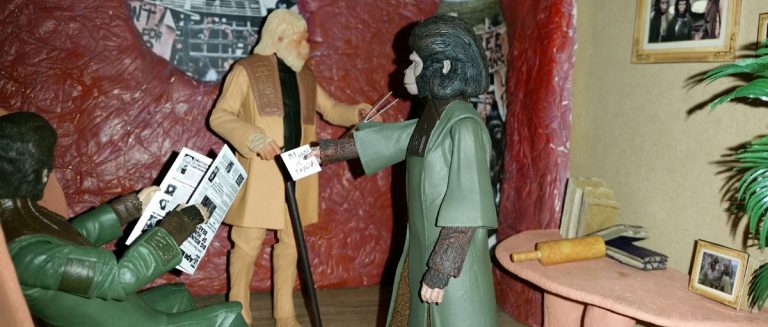The collector’s world is a strange one, but kind of like any world really. Once you get to know it, it’s easy.
I got into collecting figures accidentally when I purchased a Dr Zaius figure for a bit of fun about 4 or 5 years ago now. I am a fan of the classic Planet of the Apes movies and Dr Zaius was one of the most memorable characters in the show. The Neca figure I had in my hand was so impressive I wanted another… and that’s where my collecting bug started!
Never having been a “collector” before I had no idea where to start. First thing I got onto was Ebay where I had bought the Dr Zaius figure (for $35+$15 postage) to have a look-see at what else was available there. Not much it seemed.
Google gave me a few links to follow. The Neca website itself didn’t say much about the ape figures that I didn’t already know by now (entries were found in their archived section) but it was there that I found out they only manufacture and release a limited number of figurines and then they don’t make any more.
That is when I worked out how the collecting world works! Only so many figures are made and they get released to the public and the first to get their paws on the figures are usually the lucky ones. Figure prices increase when the figures become hard to find. Ha! I knew there must have been a trick to it and now I understood how it worked.

I started collecting for fun, for my own amusement only. I had decided to create my own apes diorama too (an ape scene I could create and build on as a hobby) and I needed some more characters to set my scene so I bought a few extras just in case I might need them.
I mention this now mainly to distinguish between the collector for personal hobby and the collector for personal profit. At some point they can easily intermingle, and there is a big difference in the motivations behind each.
What’s the difference?
The personal hobby collector will hang on to their figures for a long time. Most of their collection is not for sale and there’s not much chance of you buying an item from their treasured collection unless you have something better to swap with.
Sure, one day, later in life their whole collection may be on the market but more often than not when they do become available it is because the previous owner may have died or become too infirm to care as their family disperses it for them. The boxes will have been thrown out and their figures will be used, but that’s okay too.
The business collector on the other hand might also hang onto an item but everything is for sale at the right price. They are nearly always willing to part with a figure if you can offer them a fair price.
Profit might not be in monetary terms. It could be profit by swap too. One hard-to-find figure for 2, 3 or 4 other figures etc.
The art of collecting for profit involves buying the right figurines at their lowest price and then selling them off at their highest price.
Kind of like dealing in share-markets.
Hobby collectors are good value if you are looking for items you will be using yourself. Sometimes you can purchase displayed items at half of their value or less because they are without boxes or packaging damaged. I have purchased a number of pre-loved figurines for use in my own diorama.
As for prices in general, my research suggests that manufacturers will set their wholesale/retail prices and these will be mostly set in stone. Most retailers then sell them at that price and if you’re lucky retailers will put them on sale or discount them towards the end of their stocks to make room for more. Once the figures are all sold out from the stores then the prices will fluctuate dramatically.
The retail price and the going price (value) of figurines varies wildly for a few reasons.
When there’s high demand for a particular figure and everyone who has one is keeping them then the price can increase substantially. On the other hand when a figure is in low demand and has flooded the market then the price will drop dramatically.
The art of collecting for profit involves knowing what’s going to be popular in advance, then purchasing the right figures as they’re released.
Collector’s for profit will hold on to a figure for many years hoping some big event will happen to bring their figures back in high demand. A new movie coming out, for instance, might see figure prices soar. An actor’s passing can also bring on the rush.
Things to remember when collecting for profit:
People prefer new stuff in perfect condition. Any blemish or damage will devalue an item.
Boxes are important. Never take figures out of their boxes as damaged or missing packaging can reduce the value by up to half. Keeping extra packaging can also increase its value.
Storage is important. Store figures securely away from wet areas, smoking areas or wood-stoves, it can cause mold or yellowing and will reduce figure value. Make sure the area is well ventilated and away from mice or bugs.
Finally, when you’re on the hunt for a figure it is often the chase that counts.
You might have 9 pieces of a 10 piece set and can’t source the last one anywhere. That’s when things get tight. You can hold your ground and wait until you find it at a fair price or you can pay through the nose to finish your set off and be done with it.
Some people will never sell their prized figurines, but thankfully, some people will.

